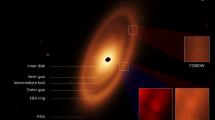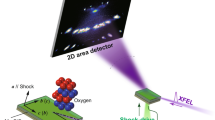Abstract
ON the night of Tuesday, April 2, at about 7.55 o'clock, I was standing with two companions, facing the north, when we were surprised to observe the ground before us suddenly lighted up, and our three shadows sharply denned upon it. One of my friends exclaimed, “Why, there's the moon come out!” We turned round and beheld a wonderfully brilliant meteor descending almost perpendicularly from about 5° east of Betelgeux, in Orion, towards the most eastern of the three stars in the belt. Its course was slightly zig-zag, its colour yellow or orange, its apparent size about half the diameter of the full moon. It vanished noiselessly before reaching the belt, and left no visible remains. When we first saw it there appeared be a short trail of light behind it. About three minutes after its disappearance a rumbling sound was heard like distant thunder, from the same direction. Whether this was connected with the meteor I cannot tell. If so it would indicate a distance of about forty miles, and we ought to hear of this meteor from the neighbour hood of Warwick.
This is a preview of subscription content, access via your institution
Access options
Subscribe to this journal
Receive 51 print issues and online access
$199.00 per year
only $3.90 per issue
Buy this article
- Purchase on SpringerLink
- Instant access to full article PDF
Prices may be subject to local taxes which are calculated during checkout
Similar content being viewed by others
Author information
Authors and Affiliations
Rights and permissions
About this article
Cite this article
MOTT, F. Meteor. Nature 17, 467 (1878). https://doi.org/10.1038/017467b0
Issue date:
DOI: https://doi.org/10.1038/017467b0



